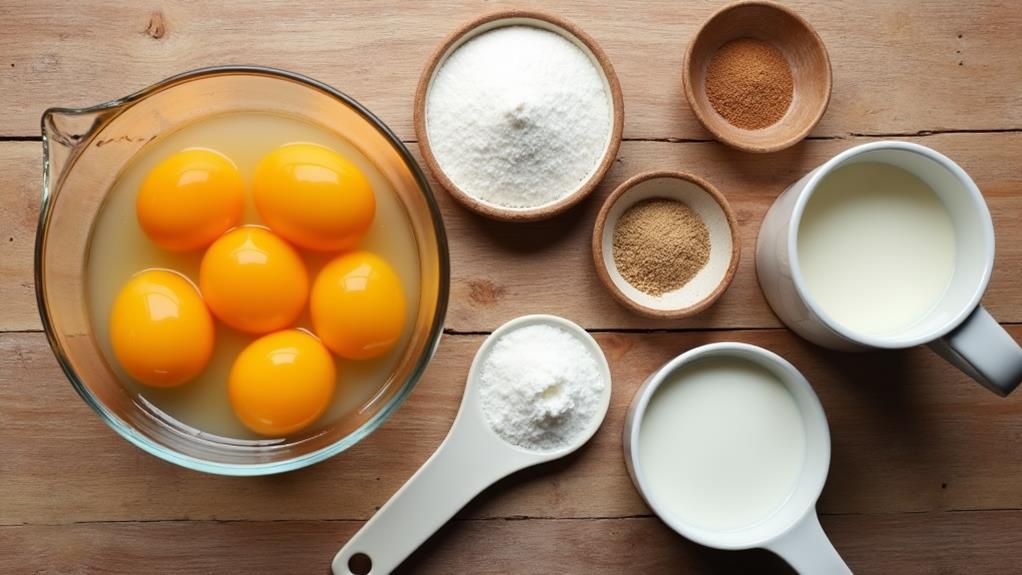When you think about holiday traditions, you might not immediately consider eggnog, yet this creamy concoction has a fascinating history that dates back centuries. Originating from medieval Britain, it transformed in America, becoming a staple at festive gatherings, and even graced the tables of George Washington. With its rich blend of egg yolks, cream, and spices, eggnog can be made in countless variations, each with its own twist. But what does this beloved drink reveal about cultural shifts and preferences over time? Let's explore that intriguing connection.
Key Takeaways
- Eggnog originated from the medieval British drink posset and became popular in 18th-century America, especially among the aristocracy.
- Traditional eggnog is made with egg yolks, sugar, cream, milk, and nutmeg, with optional alcohol like rum or bourbon.
- To prepare eggnog, whisk egg yolks and sugar, heat milk and cream, temper the mixture, and chill for enhanced flavor.
- Always use pasteurized eggs for safety, and chilling overnight improves the taste and texture of the eggnog.
- Variations like Coquito and Rompope offer unique twists on eggnog, showcasing global beverage traditions during the holiday season.
History
Eggnog has its roots in the medieval British drink known as posset, which mixed curdled milk with ale or wine. This historical concoction laid the groundwork for what we now cherish as eggnog, a beloved holiday tradition.
The term "nog," referring to a strong beer brewed in East Anglia, first popped up in print in 1693, showing that even then, folks were keen on a good drink. By the 18th century, eggnog gained traction in America, especially among the aristocracy. George Washington, a true pioneer of festive gatherings, famously served an eggnog-like drink to his visitors, adding a touch of elegance to the holiday season.
As you sip your creamy delight, remember that eggnog's cultural significance runs deep, with its earliest documented reference appearing in a poem by Jonathan Boucher in 1775.
Over the years, this drink has transformed into a staple during the Christmas season, with countless regional variations reflecting the unique flavors and traditions of different areas.
Recipe

Eggnog is a beloved holiday beverage that has been enjoyed for centuries. This creamy, rich drink is made primarily from egg yolks, sugar, milk, cream, and a hint of nutmeg, offering a delightful balance of flavors that evoke warmth and festivity. While traditionally served during the winter months, particularly around Christmas and New Year, eggnog can be savored any time of year—especially by those who appreciate its indulgent nature.
Making homemade eggnog is a straightforward process that involves a few key steps to guarantee a smooth and flavorful result. By whisking the egg yolks and sugar until creamy, then gently heating the milk and cream mixture, you create a base that can be enjoyed as-is or enhanced with the addition of your favorite spirits. This recipe will guide you through crafting a delicious batch of eggnog that's sure to impress your family and friends.
Ingredients:
- 6 large egg yolks
- 1/2 cup granulated sugar
- 1 cup heavy whipping cream
- 2 cups milk
- 1/2 teaspoon ground nutmeg
- (Optional) 1/4 cup rum or bourbon
- (Optional) 1 teaspoon vanilla extract
To prepare the eggnog, start by whisking the egg yolks and granulated sugar together in a mixing bowl until the mixture becomes creamy and pale in color. In a saucepan, heat the heavy whipping cream and milk over medium heat, stirring occasionally until it's just about to simmer.
Gradually temper the egg mixture by slowly adding a small amount of the hot cream mixture into the egg yolks while whisking continuously, then pour the egg mixture back into the saucepan. Cook the mixture over low heat, stirring constantly until it thickens slightly, about 5-7 minutes. Remove from heat, stir in the nutmeg, and if desired, add the alcohol and vanilla extract.
Allow the eggnog to cool before transferring it to the refrigerator to chill for at least a few hours, allowing the flavors to meld.
When making eggnog, it's essential to guarantee that your ingredients are fresh, particularly the eggs, to ensure a safe and flavorful beverage. For a smoother texture, consider straining the eggnog mixture through a fine-mesh sieve before chilling it. If you prefer a thicker eggnog, you can increase the ratio of egg yolks or use less milk.
Remember that the longer you refrigerate the eggnog, the more the flavors will develop, so it's worth preparing it a day in advance if possible.
Similar dishes to eggnog include custards and various holiday punches that feature creamy bases, such as coquito, a coconut-based drink from Puerto Rico, or the traditional German egg-based beverage known as advocaat. Each of these drinks provides a unique twist on the classic eggnog concept, allowing for different flavor profiles while utilizing similar ingredients.
Final Notes
When preparing homemade eggnog, it's helpful to keep a few final notes in mind to guarantee a delightful experience.
First, using pasteurized eggs can ease your mind about safety, especially when you're whipping up that creamy mixture with egg yolks, sugar, milk, and heavy cream.
Don't skimp on the nutmeg; it truly elevates the flavor and adds that classic holiday touch.
You can customize your traditional eggnog to be either alcoholic or non-alcoholic. If you choose to add a splash of rum, bourbon, or brandy, it'll warm your spirits, but even without alcohol, it remains a festive delight.
Consider making your eggnog in advance. Chilling it overnight not only enhances the flavors but also gives you more time to enjoy the holiday season with friends and family.
Plus, it can be stored in the refrigerator for up to three days, or even frozen for up to six months!
Lastly, explore variations from around the world—like coquito from Puerto Rico or rompope from Mexico—to add a unique twist to your eggnog experience.
With these tips, you're all set to impress during the holidays!
